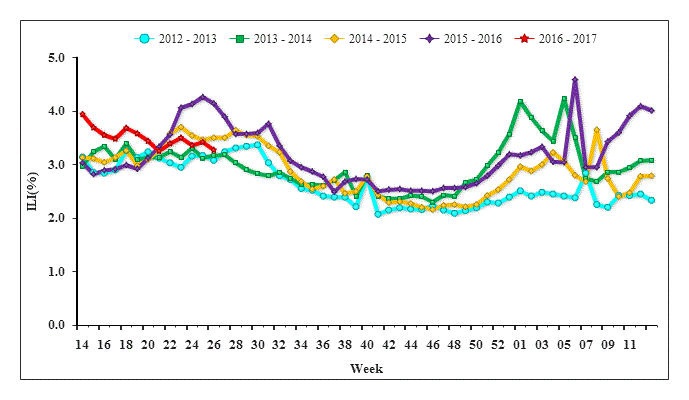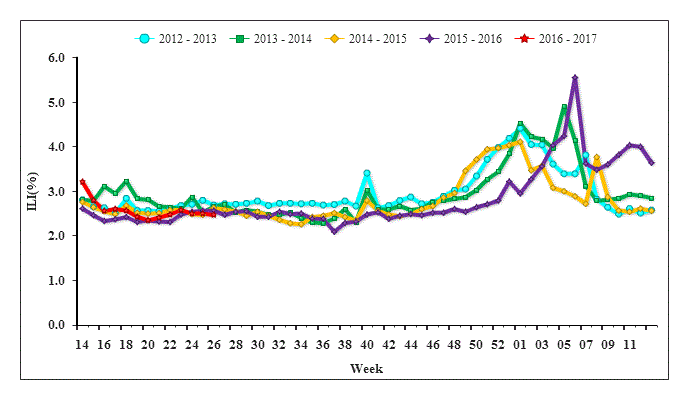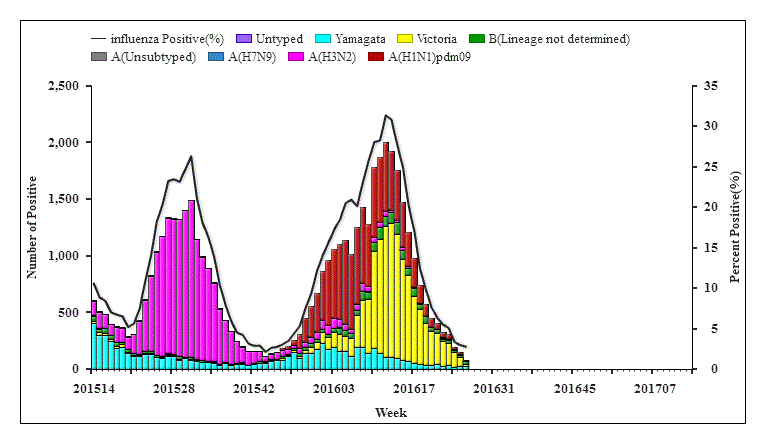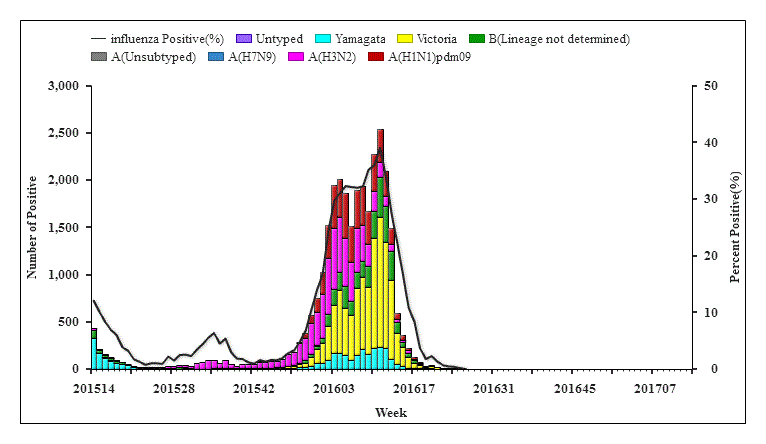Weekly Report
week 26 2016
Article source: Date time:2016-07-12
Chinese Influenza Weekly Report
(All data are preliminary and may change as more reports are received)
|
Summary l During week 26, influenza activity in south China was low with influenza B detections predominating. In north China, there was almost no influenza activity detected. l Among influenza viruses antigenically characterized by CNIC since October, 2015, 689(97.2%)influenza A(H1N1)pdm09 viruses were characterized as A/California/7/2009-like; 141(52.2%) influenza A(H3N2) viruses were characterized as A/Switzerland/9715293/2013 (H3N2)(EGG)-like,234(86.7%) influenza A(H3N2) viruses were characterized as A/Switzerland/9715293/2013 (H3N2)(CELL)-like; 529(98.7%) influenza B/Yamagata viruses were characterized as B/Phuket/3073/2013-like. 743(76.6%) influenza B/Victoria viruses were characterized as B/Brisbane/60/2008-like. l Among the influenza viruses tested by CNIC for antiviral resistance analysis since October, 2015, all influenza A(H1N1)pdm09 and all influenza A(H3N2) viruses were resistant to adamantine; all influenza H3N2 and B viruses were sensitive to neuraminidase inhibitors. All but 4influenza A(H1N1)pdm09 viruses were sensitive to neuraminidase inhibitors. |
Outbreak Surveillance
During week 26(June 27–July 3, 2016), there were no outbreak reported nationwide .
Surveillance of outpatient or emergency visits for Influenza-like Illness (ILI)
During week 26, the percentage of outpatient or emergency visits for ILI (ILI %) at national sentinel hospitals in south China was 3.3% , lower than the last week,the same week of 2014 and 2015(3.4%、3.5% and 4.1%). (Figure 1)

Figure 1. Percentage of Visits for ILI at Sentinel Hospitals in South China
(2012-2016)
During week 26, ILI% at national sentinel hospitals in north China was 2.5%, same as last week(2.5%), lower than the same week of 2014 and 2015(both 2.6%). (Figure 2)

Figure 2. Percentage of Visits for ILI at Sentinel Hospitals in North China
(2012-2016)
Virologic Surveillance
During week 26, influenza network laboratories tested 3482 specimens, of which 79 (2.3%) were positive for influenza, influenza A and influenza B virus were 12(15.2%) and 67(84.8%), respectively (Table 1). During week 26, the percentage of specimens that were tested positive for influenza in south China was 2.8%, which was lower than the previous week (3.1%) (Figure 3). During week 26, the percentage of specimens that were tested positive for influenza in north China was 0%, which was low than the previous week (0.2%)(Figure 4).
Table 1 Laboratory Detections of ILI Specimens (Week 26, 2016)
|
|
Week 26 |
||
|
South China |
North China |
Total |
|
|
No. of specimens tested |
2867 |
615 |
3482 |
|
No. of positive specimens (%) |
79(2.8%) |
0(0) |
79(2.3%) |
|
Influenza A |
12(15.2%) |
0(0) |
12(15.2%) |
|
A(H3N2) |
3(25.0%) |
0(0) |
3(25.0%) |
|
A(H1N1)pdm09 |
9(75.0%) |
0(0) |
9(75.0%) |
|
A (subtype not determined) |
0(0) |
0(0) |
0(0) |
|
Influenza B |
67(84.8%) |
0(0) |
67(84.8%) |
|
B (lineage not determined) |
25(37.3%) |
0(0) |
25(37.3%) |
|
Victoria |
23(34.3%) |
0(0) |
23(34.3%) |
|
Yamagata |
19(28.4%) |
0(0) |
19(28.4%) |

Figure 3. Influenza Positive Tests Reported by Southern Network Laboratories (Week 14, 2015–Week 26, 2016)
Note: Analysis in this part was based on the test results of network laboratories. If it were not consistent with the results of CNIC confirmation, the results of CNIC confirmation were used.

Figure 4. Influenza Positive Tests Reported by Northern Network Laboratories (Week 14, 2015–Week 26, 2016)
Note: Analysis in this part was based on the result of network laboratories. If it were not consistent with the results of CNIC confirmation, the results of CNIC confirmation were used.
Antigenic Characterization
Since October 1st, 2015, 689(97.2%) of the 709 A(H1N1)pdm09 viruses tested were characterized as A/California/7/2009-like; 141(52.2%) of the 270 A(H3N2) influenza viruses tested were characterized as A/Switzerland/9715293/2013 (H3N2)(EGG)-like, 234(86.7%) of the 270 A(H3N2) influenza viruses tested were characterized as A/Switzerland/9715293/2013 (H3N2)(CELL)-like; 529(98.7%) of the 536 influenza B/Yamagata lineage viruses tested were characterized as B/Phuket/3073/2013-like; 743(76.6%)of the 970 influenza B/Victoria lineage viruses tested have been characterized as B/Brisbane/60/2008-like.
Antiviral Resistance
Since October 1st, 2015, among the influenza viruses tested by CNIC for antiviral resistance, all influenza A(H1N1)pdm09 and all influenza A(H3N2) viruses were resistant to adamantine ; all influenza A(H3N2) and B viruses were sensitive to neuraminidase inhibitors. All but 4influenza A(H1N1)pdm09 viruses were sensitive to neuraminidase inhibitors.

